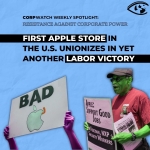USA: Unhappy Meals
School lunches are loaded with fat -- and the beef and dairy industries are making sure it stays that way.
Every weekday at lunch, courtesy of the federal government, more than
27 million schoolchildren sit down to the nation's largest mass feeding. If
we took a giant snapshot of their trays on a typical day -- say, Tuesday,
September 24 -- here's what the continent-wide photo would look like:
In Lynnwood, Washington, we would see kids eating sausage with Belgian
waffle sticks and syrup. In Clovis, California, bacon cheeseburgers. In La
Quinta, California, Canadian bacon and cheese rolls. In Rexburg, Idaho,
cheese nachos and waffles. In Fort Collins, Colorado, "homemade" pigs in a
blanket. In Bryan, Texas, cheeseburgers, chicken-fried steak, and pizza. In
Hot Springs, Arkansas, country steak with creamed potatoes. In Cedar Falls,
Iowa, mini-corndogs. In Lafayette, Indiana, beef ravioli with cheesy
broccoli. In Columbus, Ohio, egg rolls with tater tots. In Kingstree, South
Carolina, sloppy joes with onion rings. In Richmond, Virginia, chili cheese
nachos. In Gatesville, North Carolina, three-meat subs with Fritos. In
Orwigsburg, Pennsylvania, cheese steak on rolls with buttered pasta. And in
Fitchburg, Massachusetts, pretzels with cheese sauce.
Here and there, we'd also see baked chicken and salads. But by and
large, school cafeterias coast to coast offer an artery-clogging menu of
beef, pork, cheese, and grease. "Whenever I see children clinically, I ask
them if they buy lunch at school or bring it from home," says Patricia
Froberg, a nutritionist at Connecticut Children's Medical Center in
Hartford. "If they say, 'I get it at school,' I cringe."
At a time when weight-related illnesses in children are escalating,
schools are serving kids the very foods that lead to obesity, diabetes, and
heart disease. That's because the National School Lunch Program, which gives
schools more than $6 billion each year to offer low-cost meals to students,
has conflicting missions. Enacted in 1946, the program is supposed to
provide healthy meals to children, regardless of income. At the same time,
however, it's designed to subsidize agribusiness, shoring up demand for beef
and milk even as the public's taste for these foods declines.
Under the program, the federal government buys up more than $800
million worth of farm products each year and turns them over to schools to
serve their students. The U.S. Department of Agriculture, which administers
the system, calls this a win-win situation: Schools get free ingredients
while farmers are guaranteed a steady income. The trouble is, most of the
commodities provided to schools are meat and dairy products, often laden
with saturated fat. In 2001, the USDA spent a total of $350 million on
surplus beef and cheese for schools -- more than double the $161 million
spent on all fruits and vegetables, most of which were canned or frozen. On
top of its regular purchases, the USDA makes special purchases in direct
response to industry lobbying. In November 2001, for example, the beef
industry wrote to Agriculture Secretary Ann Veneman, complaining that a
decline in travel after September 11, along with a lowered demand for beef
in Japan, was suppressing sales of their product. The department responded
two months later with a $30 million
"bonus buy" of frozen beef roasts and ground beef for schools.
"Basically, it's a welfare program for suppliers of commodities," says
Jennifer Raymond, a retired nutritionist in Northern California who has
worked with schools to develop healthier menus. "It's a price support
program for agricultural producers, and the schools are simply a way to get
rid of the items that have been purchased."
The complete version of Unhappy Meals can be read in the January/February,
2003 issue of Mother Jones magazine.
- 188 Consumerism & Commercialism


